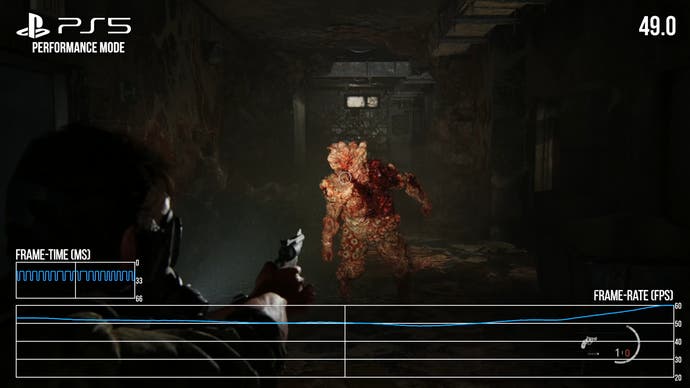The Last of Us Part 1: all performance modes tested, which should you use?
60Hz, 120Hz and VRR modes under the microscope.
The Last of Us on PS3 was a boundary-pushing title with stunning graphics and animation. Novel techniques - like capsule shadows and real-time bounce lighting - alongside ruthless attention to detail produced one of the most technically accomplished games in its time, even though it often failed to reach its 30fps target, frequently dipping into the mid-20s in combat and traversal sequences. Enter The Last of Us Part 1.
Some nine-and-a-half years after its original release, The Last of Us has been fully remade with modern technology on PS5 hardware. With an advanced suite of graphics tech in tow, does the remake also blow past its frame-time budgets? Or has Naughty Dog more sensibly balanced visual beauty with fluid frame-rates?
The Last of Us Part 1 offers players five genuine visual modes, engaged through various selections and system-level tweaks. With the PS5 set to 60Hz output, you get the option of a fidelity mode that offers 4K visuals with a 30fps target framerate, alongside a performance mode that advertises dynamic 4K visuals or native 1440p visuals depending on your output resolution - but actually delivers 1440p regardless. With 120Hz engaged, you get the same options, though the fidelity mode now promises a 40fps framerate target. As an additional modifier, engaging both 120Hz and VRR gives you the option to 'unlock' the 120Hz options, maximising frame-rate and using VRR to smooth out any inconsistencies.
| 60Hz modes | 120Hz modes | 120Hz + VRR modes |
|---|---|---|
| Fidelity (4K, 30fps) | Fidelity (4K, 40fps) | Fidelity unlocked (4K, 40fps+) |
| Performance (1440p, 60fps) | Performance unlocked (1440p, 60fps+) | |
So let's unravel these options, starting with the 4K output performance mode. Thankfully, results here are very straightforward. Essentially, this performance mode offers a very convincing 60fps update. If you've played The Last of Us Part 2 on PS5 you'll have a good idea of what to expect: a very smooth and stable 60fps even in intense scenes, with only five instances of frame-rate drops in gameplay and only one that proved actually disruptive - a hallway encounter a third of the way through the game that repeatedly produced frame-rates in the 50 to 55fps range. The game's cutscenes do drop one frame in advance of camera cuts so the engine can generate a spare frame to use for TAA, but this is difficult to notice in the performance mode.
Let's address the last of the conventional modes next - the fidelity mode at 60Hz output. This mode advertises a 4K 30fps setup, halving frame-rate in exchange for more than double the pixel count. Fluidity takes an obvious hit, as expected, with palpably laggier controls and choppier animation owing to the increased frame-time target - but frame-rate drops are less frequent. It's essentially a straight 30fps throughout, save for a single encounter that pushed frame-rates as low as 26fps. However, there are some issues with frame delivery in this mode, with the game delivering a smattering of closely-spaced frames every so often. This isn't likely to be noticed by most players, but could still be improved.

While a full-fat 4K image is appreciated and does look very clean, the loss of fluidity relative to the performance mode is a bit painful. But what if there was an option that split the difference between these two modes? On paper, that's exactly what the 40fps fidelity mode is supposed to offer, with the same 4K resolution and a boosted frame-rate - but while 40fps modes have worked well in other PS5 titles, here there's not enough headroom over the 30fps line to take full advantage, and instead you just get a more inconsistent presentation often in the region of 35fps. Dynamic resolution by all indications isn't present either, so the title can't open up performance headroom as needed in intense scenes. On the plus side however, the frame-time fluctuations when running at 120Hz aren't as noticeable as when running at 60Hz.
The final run of unlocked frame-rate modes may be of some help here however, and are accessible when 120Hz and VRR are enabled in the PS5's console settings. This lets us run TLOU in performance mode without a frame-rate cap, leaning on VRR to smooth out frame delivery. This provides a nice increase to smoothness, with the game producing frame-rates in the 60-100fps region, most often 70-80fps. The trade-off here with the regular performance mode is essentially slightly less consistent input response and animation in exchange for a higher general frame-rate level. Plus, any dips beneath 60fps are smoothed out nicely and are essentially imperceptible, though these were rare of course even running with full v-sync. It's a nice boost - though it's only really worth it if you have a television that enables VRR without disabling features like local dimming.

The unlocked fidelity mode is considerably better than its v-synced counterpart too. The near-constant performance fumbles are smoothed out; we're mostly in 30-45fps territory but VRR keeps frame-time judder in check. The frame-rate inconsistency is much more obvious to me here than in the unlocked performance mode, but I'd still consider this clearly preferable to either of the v-synced fidelity options.
There's also the option of enabling VRR on the system level and leaving the 'unlocked framerate' toggle off in the game settings. This works essentially as expected - the performance mode runs at a straight 60fps with any momentary dips beneath smoothed out and is a reasonable option if you prefer an ultra-consistent presentation. Fidelity mode seems to work in the same fashion, but with low framerate compensation enabled - so just like the unlocked fidelity mode but with a cap at 40fps. It ends up feeling quite similar to that mode overall.
As a final note, I thought I'd do a quick comparison with prior versions of The Last of Us, starting with the flawed PS3 release. The remake has hugely improved performance relative to this earlier version. Even in demanding combat sections, the new release manages to stick firmly to its 30fps and 60fps performance targets in almost every example, without the 20-25fps lows observed on the PS3. It's a solid showing but given the graphics tech, which appears broadly in line with the PS4 exclusive The Last of Us Part 2, it isn't a particular surprise. Still, the remake pushes beautiful visuals while offering consistent performance, as long as you avoid the v-synced 40fps fidelity mode, which is quite flawed.

Measuring this title up against 2014's PS4 port, dubbed The Last of Us Remastered, gives more equivocal results. Running on PS5 hardware, The Last of Us Remastered delivers a perfect 1800p 60fps by default, with a 4K 30fps option as well. The graphics are more primitive and you can't unlock any VRR-driven frame-rate boosts, but it does deliver a similar level of performance and fluidity on the whole.
So, the final verdict. Of the five actual graphics modes on tap, I'd only advise against one - the 4K 40fps fidelity mode without VRR - due to its inconsistent performance. The other modes offer varying degrees of fluidity and consistency, but all have their own reasonable merits and tradeoffs. My personal preference is for the performance modes, as I didn't find that the boost to 4K made enough of a visual impact at typical viewing distances to compromise frame-rates. I'm particularly partial to the unlocked performance option and its VRR-fueled smoothness.
For deeper technical and gameplay coverage of the game itself I'd recommend checking out John's excellent analysis, which covers the various enhancements and changes in great detail.
As a fan of the original game myself I came away pleased with this effort. I would have appreciated a greater gameplay mix-up as most of the old tricks and exploits players use to beat the game on higher difficulties still work. However, big presentational improvements, including hugely boosted graphics and animation, alongside more realistic AI routines and other gameplay tweaks, render this a worthy remake effort. That largely extends to performance as well, though the 40fps mode could use tweaks to ensure a more stable output. As it stands, The Last of Us Part 1 has consistent and solid performance across a healthy variety of visual options, and is hugely improved over its PS3 predecessor.










